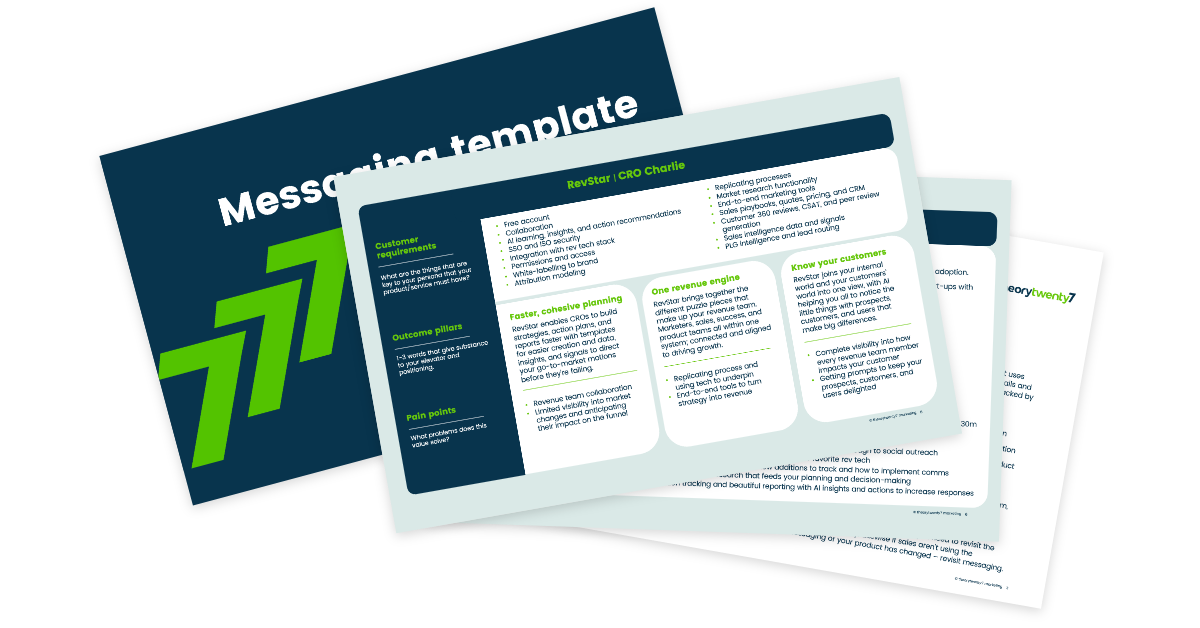SaaS Start-Up Product Messaging PowerPoint Template + Guide

Build the key messages of value for your buyers with this editable messaging template for SaaS start-ups!
Get started with creating your product messaging matrix in this template. Easy to complete and with a built-in how-to guide for beginners, download it today for:
- A step-by-step process to linking your personas and value to your product
- Advice on how to keep focused on the message
- An explanation of how messaging fits into a wider product marketing strategy
- "CRO Charlie" - a completed SaaS example of messaging a product
- Editable slides you can brand and export to PDF
Download Your Product Messaging Template
SaaS Product Messaging FAQs
Do you have questions about whether your product or service needs messaging or how this template helps? We've got answers!
-
The way buyers see your product is a result of the way you message it…
That’s because messaging connects your target companies and buyers directly to their pains and the value you offer to soothe them.
It takes considerable research, but that’s because it’s never a one -and- done.
It's a great system to run, from defining your product in one to two sentences and elevator pitches to grouping buyer challenges and desired outcomes with your product’s features, benefits, and the proof to back it up.
-
Positioning and messaging are two different but often confused elements of product marketing.
Positioning is the bedrock for messaging, determining where a product stands. It's crucial as it provides your customers with the context of how your product fits into the product landscape.
Messaging involves explaining your product's benefits and value to your customers.
While positioning sets the strategy, messaging breathes life into your story, helping buyers better understand your product.
-
A messaging framework is a roadmap that shows what your company and products are all about. It's a structured way to highlight the value you offer to your buyers.
It explains the what, why, and how to find your ICP and is a tool for defining the "why" of your SaaS.
By imagining, crafting, and expressing your software's core message, you will gain a deeper understanding of your offerings and the benefits they bring to your buyers. This will create clarity and build trust and loyalty to your software.
-
You start with this template!
OK, well, back up - follow this process:-
Start with the value proposition and how you would summarize the value you deliver to buyers
-
Describe the persona this messaging is for to contextualize your value proposition. Remember that buyers want relevant buying experiences, and that starts here.
-
Create a one to two-sentence elevator pitch that captures why that persona would find your software valuable
-
Build a 100-200 word description of the software that uses your value proposition to describe your product’s details and benefits, linked to your target market and persona, backed by stats, customers, awards, and more
-
Describe the tone of voice your persona would like
-
List the outcomes that this person wants from a solution
-
List the requirements that this person wants from a solution
-
Identify three outcomes and group pain points with product features, benefits, details, and proof points
-
Review this every six to twelve months.
-
Test the messaging using your website, content, sales team, and wherever you can A/B test.
-
Be sure to track if the promises you made in the value proposition come to fruition as the buyer becomes a customer – if they report otherwise, you need to revisit the messaging urgently. Likewise, if sales aren’t using the messaging or your product has changed – revisit messaging
-
-
Absolutely!
Your messaging is the connective tissue between your buyers and your product or service.
If you cannot talk the talk, it doesn't matter if your product or service walks the walk.
This isn't a quick process, but one that will help you to drive growth.
-
Messaging fits into a wider product marketing strategy, which we call a pyramid.
These are the layers and how messaging fits in:
- Positioning: Refresh positioning every two years
- Ideal customers: Identify one ideal customer profile and run hypotheses for new ones every year
- Ideal buyers: Cement 1-3 ideal buyer personas to cover buyers, influencers, and users – refresh every two years
- Messaging: Build value-based messages per persona and test bi-annual
- Campaigns: Run quarterly campaigns testing all the above
- Tactics: Think networking, events, SEO, content, demand gen, paid ads, lead gen, partnerships, and marketplaces
